Avondale Shipyard was an independent shipbuilding company, acquired by Litton Industries, in turn acquired by Northrop Grumman Corporation. In 2011, along with the former Ingalls Shipbuilding, the yard was part of Huntington Ingalls Industries. It closed in October 2014. The yard was located on the west bank of the Mississippi River in an area called Bridge City, about 20 miles (32 km) upriver from New Orleans near Westwego, Louisiana. It was the site of the modernization of the battleship USS Iowa in the early 1980s and also constructed some of the lighter aboard ships (LASH). At one time, it was the largest employer in Louisiana, with about 26,000 employees.

The T2 tanker, or T2, was a class of oil tanker constructed and produced in large numbers in the United States during World War II. Only the T3 tankers were larger "navy oilers" of the period. Some 533 T2s were built between 1940 and the end of 1945. They were used to transport fuel oil, diesel fuel, gasoline and sometimes black oil-crude oil. Post war many T2s remained in use; like other hastily built World War II ships pressed into peacetime service, there were safety concerns. As was found during the war, the United States Coast Guard Marine Board of Investigation in 1952 stated that in cold weather the ships were prone to metal fatigue cracking, so were "belted" with steel straps. This occurred after two T2s, Pendleton and Fort Mercer, split in two off Cape Cod within hours of each other. Pendleton's sinking is memorialized in the 2016 film The Finest Hours. Engineering inquiries into the problem suggested the cause was poor welding techniques. It was found the steel was not well suited for the new wartime welding construction. The high sulfur content made the steel brittle and prone to metal fatigue at lower temperatures.

Coastal trading vessels, also known as coasters or skoots, are shallow-hulled merchant ships used for transporting cargo along a coastline. Their shallow hulls mean that they can get through reefs where deeper-hulled seagoing ships usually cannot, but as a result they are not optimized for the large waves found on the open ocean. Coasters can load and unload cargo in shallow ports. For European inland waterways, they are limited to a 33,49 m beam.

The Auk class were a class of minesweepers serving with the United States Navy and the Royal Navy during the Second World War. In total, there were 93 Auks built.
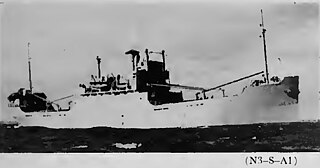
Type N3-S ships were a Maritime Commission small coastal cargo ship design to meet urgent World War II shipping needs, with the first of the 109 N3, both steam and diesel, type hulls delivered in December 1942.
The American Ship Building Company was the dominant shipbuilder on the Great Lakes before the Second World War. It started as Cleveland Shipbuilding in Cleveland, Ohio in 1888 and opened the yard in Lorain, Ohio in 1898. It changed its name to the American Ship Building Company in 1900, when it acquired Superior Shipbuilding, in Superior, Wisconsin; Toledo Shipbuilding, in Toledo, Ohio; and West Bay Shipbuilding, in West Bay City, Michigan. With the coming of World War I, the company also acquired Buffalo Dry Dock, in Buffalo, New York; Chicago Shipbuilding, in Chicago, Illinois; and Detroit Shipbuilding, in Wyandotte, Michigan. American Shipbuilding ranked 81st among United States corporations in the value of World War II military production contracts.
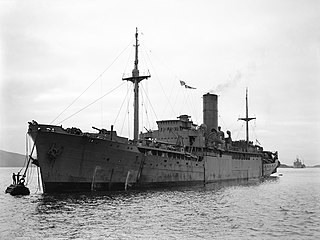
HMS Agamemnon was originally the Blue Funnel Line refrigerated cargo ship Agamemnon. She was built in 1929, traded between the UK and the Far East, and was scrapped in 1963. During the Second World War she was converted into an auxiliary minelayer in 1940, and then into an amenities ship in 1943.
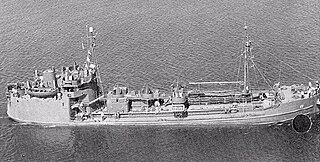
The T1 tanker or T1 are a class of sea worthy small tanker ships used to transport fuel oil before and during World War II, Korean War and Vietnam War. The T1 tanker classification is still in use today. T1 tankers are about 200 to 250 feet in length and are able to sustain a top speed of about 12 knots. The hull designation AO is used by the US Navy to denote the ship is a T1 oil tanker and AOG that the T1 is a gasoline tanker. The small size allows the T1 to enter just about any sea port or to anchor around a small island, this was very useful during the Pacific War. The T1 tanker can carry about 48,000 to 280,000 bbls. Some T1 tankers were used to transport goods other than oil, a few were used for black oil-crude oil, diesel, chemicals and rarely bulk cargo like grain. T1 tankers are also called liquid cargo carriers. The T1 tanker has about a 6,000 to 35,000 deadweight tonnage (DWT) of cargo. The small size also gives the ships short turn around time for repair, cleaning, loading and unloading. A T1 tanker carrying dirty cargo, like crude oil needs a few weeks of labor to clean before carrying clean cargo. Most T1 ships during World War II were named after major oil fields.

The Type V ship is a United States Maritime Commission (MARCOM) designation for World War II tugboats. Type V was used in World War II, Korean War, and the Vietnam War. Type V ships were used to move ships and barges. Type V tugboats were made of either steel or wood hulls. There were four types of tugboats ordered for World War II. The largest type V design was the sea worthy 186-foot (57 m) long steel hull, V4-M-A1. The V4-M-A1 design was used by a number of manufacturers; a total of 49 were built. A smaller steel hull tugboat was the 94-foot (29 m) V2-ME-A1; 26 were built. The largest wooden hull was the 148-foot (45 m) V3-S-AH2, of which 14 were built. The smaller wooden hull was the 58-foot (18 m) V2-M-AL1, which 35 were built. Most V2-M-AL1 tugboats were sent to the United Kingdom for the war efforts under the lend-lease act. The Type V tugs served across the globe during World War II including: Pacific War, European theatre, and in the United States. SS Farallon, and other Type V tugs, were used to help built Normandy ports, including Mulberry harbour, on D-Day, 6 June 1944, and made nine round trips to Normandy to deliver Phoenix breakwaters.

The McDougall Duluth Shipbuilding Company was a large-scale wartime ship manufacturing shipyard, located at the city of Riverside, near Duluth. McDougall Duluth Shipbuilding was at 110 Spring Street, Duluth, Minnesota, now the site of the West Duluth's Spirit Lake Marina. The shipyard was located on St. Louis River Estuary at western part of Lake Superior. McDougall Duluth Shipbuilding Company was founded by Alexander McDougall (1845-1923) in 1917 to build ships for World War I. McDougall Duluth Shipbuilding Company and the Superior Shipbuilding Company were called the Twin Ports shipbuilding industry of Minnesota and Wisconsin. Once built the ships can travel to the Atlantic Ocean through the Great Lakes and the Saint Lawrence Seaway.

Walter Butler Shipbuilders Inc. was a large-scale World War II ship manufacturing shipyard, located at Superior, Wisconsin. Walter Butler purchased the shipyard from Lake Superior Shipbuilding in 1942. Walter Butler Shipbuilders Inc. was at E 1st St, Superior, Wisconsin. The shipyard was located on the western part of Lake Superior. Walter Butler Shipbuilders Inc. was found by Walter Butler in 1942 to build ships for World War II. Walter Butler Shipbuilders Inc., the McDougall Duluth Shipbuilding Company and the Superior Shipbuilding Company were called the Twin Ports shipbuilding industry of Minnesota and Wisconsin. Once built the ships can travel to the Atlantic Ocean through the Great Lakes and the Saint Lawrence Seaway.

Fellows & Stewart Inc. was a shipbuilding company in San Pedro, California on Terminal Island's Pier 206. To support the World War II demand for ships Fellows & Stewart built Crash rescue boats and submarine chasers. The Crash rescue boats were operated by both the US Navy and US Army during the war. Some crash rescue boat also served in the Korean War. Fellows & Stewart was founded as Joe Fellows Boat Shop in 1896. Joe Fellows was an English immigrant who learned boat building in Seattle and San Francisco. The company changed to Fellows & Stewart as the shipyard manager, Victor Stewart joined in as a partner. Many of the boats were designed by Joseph Pugh. From 1907 to 1917 called the Joe Fellows Yacht and Launch Company. In the 1910s, 1920s and 1930s the shipyard built many yachts and sailboats. The name changed to the Fellows & Stewart Inc. in 1917. In 1967 the shipyard was sold to Harbor Boatbuilding. The shipyard is sometimes listed as being in Wilmington. The records of Fellows & Stewart are housed at the Los Angeles Maritime Museum. Notable boats and ships: HMAS Air View, USS SC-1012, Rudolph Valentino's 1926 yacht Charade (Phoenix) and the Ranger built in 1917 active at the Santa Barbara Maritime Museum.

Fulton Shipyard was a shipbuilding company in Antioch, California. The shipyard was founded in 1924 by Frank Fulton and Angeline Fulton Fredericks. To support the World War II demand for ships, Fulton Shipyard built minesweepers, tugboats, and troopships. The shipyard was located on the Stockton Channel at 701 Fulton Shipyard Rd, Antioch, near Antioch pier and the Antioch Dunes National Wildlife Refuge. The site was the former Jarvis Brothers, opened in 1918, then Laurtzen shipyard. In 1977 the site became the California Corporation. The shipyard closed in 1999 and the land is owned by the Fulton Family Trust. Fulton Shipyard was on the San Joaquin River and an inland port located more than seventy nautical miles from the ocean, emptying into Suisun Bay. Fulton Shipyard was featured in a 1914 movie called The Stolen Yacht, a short drama film released on November 5, 1914. Frank Fulton and Angeline's son James Lloyd Fulton became an operator of a Fulton Shipyard tugboat.
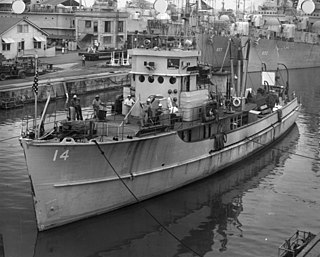
South Coast Shipyard was a shipbuilding company in Newport, California. To support the World War II demand for ships South Coast Shipyard built: minesweepers, Torpedo Boats, Submarine chasers, & Air-sea rescue boats. South Coast Shipyard was opened in 1938 by Walton Hubbard. After World War II the shipyard continued to build ships for the US Navy till 1955. The shipyard was located at 2300 Newport Boulevard, Newport, California. The shipyard closed in 1963.
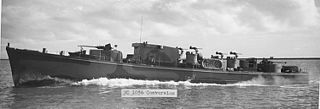
Wilmington Boat Works, Inc. or WILBO was a shipbuilding company in Wilmington, California. To support the World War 2 demand for ships Victory Shipbuilding built: Tugboats, crash rescue boats and sub chasers. Wilmington Boat Works opened in 1920 building Fishing boat and yachts, by Hugh Angelman, Willard Buchanan and Tom Smith. After the Korean War the shipyard closed in 1958. The shipyard was located at 400 Yacht Street, Wilmington, the site of the current USC boatyard.

Ackerman Boat Company was a wooden shipbuilding company in Newport Beach, California. Ackerman Boat Company built small barges in Newport Harbor working with Star D Iron Works, in Santa Ana. To support the World War 2 demand for ships Ackerman Boat Company shipyard switched over to military construction and built: US Army Harbor Tugboats and US Navy Landing Craft Mechanized Model LCM Mark 3. Clarence Ackerman started the Ackerman Boat Company was in 1943. Ackerman Boat Company worked with Consolidated Steel's Wilmington shipyard to build the Tugboat and Landing Craft. Near the end of the war, Ackerman sold the yard to Consolidated Steel but purchased it back in 1947. Ackerman sold the shipyard in 1958. The shipyard was at 151 Shipyard Way, Newport Beach on the Lido Peninsula at the corner of Rhine Place. The current site has been the Newport Harbor Shipyard since 1981, which repairs and restoration of yachts.

Splinter fleet or Splinter navy was a nickname given to the United States wooden boats used in World War II. The boats served in many different roles during the war. These boats were built in small boatyards on the West coast and East coast, Great Lakes and the Gulf of Mexico. They could be built quickly, in just 60 to 120 days. Most of the boats were built by boatyards that already had the tools and knowledge from building yachts, sailboats and motor boats. Many were built by craftsmen in family-owned small businesses. Under the Emergency Shipbuilding Program and War Shipping Administration contracts went out to over fifty boatyards across the country. The boats were built for the US Navy, the United States Army Air Forces, United States Coast Guard, and US Army. Some of the wooden boats went to Allied nations on the Lend-Lease program.

Bethlehem Beaumont Shipyard was a shipyard in Beaumont, Texas that opened in 1948. The yard is located on an island in the Neches River and upstream of the Sabine Pass that grants access to the Gulf of Mexico. The deep-water port shipyard was founded in 1917 as the Beaumont Shipbuilding & Dry Dock Company. Beaumont Shipbuilding & Dry Dock Company started as a World War I Emergency Shipbuilding Program yard.

Froemming Brothers of Milwaukee, Wisconsin was a shipyard that built ships for World War II under the emergency shipbuilding program, War Shipping Administration and United States Navy. Froemming Brothers shipyard was opened in 1942 by Ben Froemming (1902-1945). Froemming Brothers closed after the war in 1945, after building 26 ships. The shipyard was located on the north side of the Kinnickinnic River. The shipyard had 2,400 workers in three shifts. In 1945 it was sold to Wagner Iron Works and later sold to the Milwaukee Marine Yacht. The site today is Horny Goat Marina, Blue Max Charters and Clete Long Enterprises. The shipyard was in Bay View, Milwaukee neighborhood at 43.008597°N 87.911697°W.
McCloskey & Company Shipyard was a ship builder in Tampa, Florida. McCloskey & Company built 38 cargo ships, Type N3 ship for World War II founded in 1942. McCloskey & Company also built type C1-S-D1 concrete ships. Matthew H. McCloskey founded the construction company McCloskey & Company in Philadelphia. McCloskey & Company built the Philadelphia Convention Hall, the Philadelphia Sheraton Hotel, and the Washington D.C. Stadium.
The Tampa shipyard is now Tampa Ship LLC owned by Edison Chouest Offshore.

















